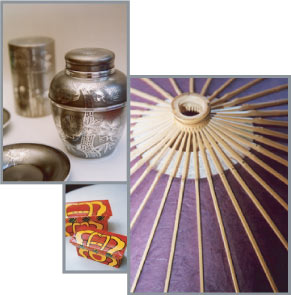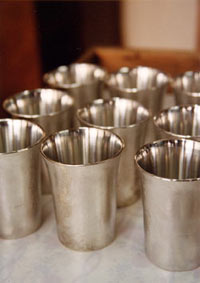 |
Satsuma
Suzuki / Satsuma Tin Ware
Tin was discovered in Kagoshima City in 1655. Tin became big
business of Kagoshima, at that time. It was very expensive metal,
same as gold and silver. Tin wares were produced only for Shimadzu
family, the lord of Satsuma (now Kagoshima). Once the production
of tin ware was established, it spread to the local people.
Before the World War 2, there were over 15 tin workshops in
Kagoshima City. However, now only 2 shops have taken over the
traditional tin wares in Kagoshima now. In general, the process
to make tin ware is as follows; Heat and melt pure tin. Mold
out the tin. Grind and polish the tin. Draw picture with lacquer,
and put the tin in acid.
There are many tin wares like sake pots and cups, wine cups,
tea leaf case, plates, flower vases. It's said that tin is effective
to purify the water. Sake warmed in a tin pot is said to be
especially delicious.
Asada Tin workshop has been taking over their tradition.
"Tin is good to the Earth. You can recycle tin many times"
Shinichiro Asada (the Second master) says "To become a
tinwork professional, it takes at least 30 years! 10 years for
casting, 10 years for shaving and 10 years for drawing. I have
been producing tinwork over 30 years, but I am still in training."
Asada Tin Workshop (Mr.Asada):
Taenokuchi-cho, Kagoshima City
/ 099-222-2752
|
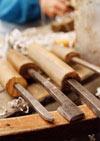 |
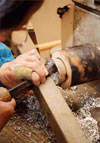 |
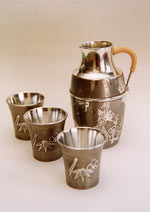 |
|
Satsuma
Kiriko
/ Satsuma Cut glass
Crimson, dark blue, golden red, yellow, purple, green.... beautiful
cut glass. It is said that Satsuma cut glass was influenced
by Chinese and Europe cultures. The cut glass work started in
Kagoshima under the direction of the lord of Satsuma in 1855.
Although cut glass  production
stopped for a while, it started again in 1985. production
stopped for a while, it started again in 1985. |
Take Seihin
/ Bamboo Craftworks
Kagoshima is the home of bamboo. Kagoshima's bamboo area is
the biggest in Japan. Many bamboo products have been produced
here for a long time. There are many bamboo products like flower
vases, Japanese tea tools, cooking tools, bags, etc. |
Washi
/ Japanese Paper
It is said that the production of Japanese paper started earlier
in Kagoshima than in other regions of Japan, because Kagoshima
used to have a lot of trees. Kamou paper is known as high quality
white paper which is usually used for ink calligraphy. Tsuruta
paper has been used for paper bags of Japanese tea for a long
time. The paper is light brown and difficult to burn. |
|
Chiran
Kasa Chochin / Chiran Umbrella Lantern
An umbrella shaped lantern is made of bamboo and Japanese paper.
It started as a samurai's job about 150 years ago. At that time,
only samurai were allowed to make umbrellas. It is said that
Gosuke Tominaga got the idea of the umbrella lantern, while
he was making an umbrella. The lantern was used as a lantern,
an umbrella, and sometimes as a weapon at that time. It was
used mainly by high class people. In the period around Taisho
to the beginning of Showa, umbrella lanterns were made of thin
silk with gorgeous paintings for interior decoration. These
beautiful lanterns were exported to America as decorative pieces
before the war. After the war started, the production of lanterns
stopped for about 40 years, until the 4th Imao Tominaga restarted
the tradition again. Now, he is the only producer of this beautiful
traditional craft work. It looks simple to make, but there is
many processes and needs very sensitive skills. Cut a bamboo
into 32 equal part, and put it together after shaving each parts
finely. Paste Japanese paper on an umbrella shaped bamboo top
and bottom. Put two umbrellas together with Japanese paper and
a lantern is formed. To produce beautiful work, you need to
be patient and have accurate skill. When it is lit, the soft
light through the Japanese paper shows you the beautiful harmony
of bamboo lines and colorful Japanese paper. Not only popular
in Japan, there are sometimes orders from abroad. Mr. Tominaga
has become the last remaining artisan of this beautiful traditional
craft.
Every process is all hand made by Mr. Tominaga, therefore he
can produce only 1 lantern every 2 day. To purchase, one must
place an order. He has order for up to a year in advance. (Lantern
costs about 13,000 ~16.000 yen.)
"Fake umbrella lanterns made of plastic (not bamboo) are
sold sometimes. So.. please look carefully"
Tominaga Kaguya Mingei (Mr. Imao Tominaga):
Koori, Chiran Town, Kagoshima
/ 0993-83-2058 |
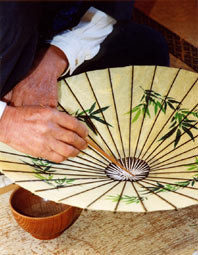 |
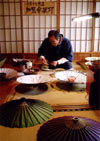 |
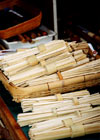 |
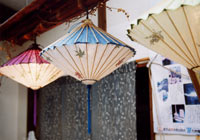 |
|
Kawanabe
Butsudan / Kawanabe Buddhist Altar
Kawanabe is located on the Southwest of Kagoshima City. This
place was well linked with Buddhism in ancient times. Therefore
some Buddha were carved on the rock or mountains, and Buddhist
calligraphy are left in Kawanabe Town. At those times, religious
people used to produce many Buddhist things, and this was transferred
to their descendants. That's why there are many factories of
Buddhist altars in the town nowadays. The altars are all hand
made and made in 7 steps (making wood material, making central
palace, carving, metal works, gold lacquer, paintings, assembly).
|
Satsuma-yaki / Satsuma
Pottery
Satsuma-pottery is one of the most well-known of Kagoshima's
traditional craftwork nowadays. It has over 400 year history,
and It was created by Korean potters who were brought to Kagoshima
by Shimadzu, the Lord of Satsuma. They created and spread
around Kagoshima prefecture an original satsuma 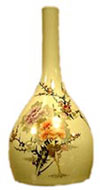 pottery
for the Lord. There are 2 types of satsuma pottery: White
and Black satsuma.
|
Yakusugi
Seihin / Yaku Cedar Craftwork
Yakushima island is one of the World's cultural and Natural
heritage site. There are beautiful sceneries and mountains over
1000m where you can find the yaku cedar which are more than
1000 years old, usually called "Yakusugi". Yakusugi
is known as high quality wood in Japan. There are many yaku
cedar products like tables, shelves, alcove posts, flower vases,
tea saucers, plates, etc. |
|
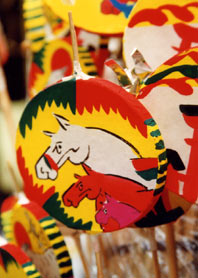 |
Tai
Kuruma / Seabream Shaped Toy ・ Koubako / Incense Box ・ Hatsu
Tsuzumi / Paper Drum Toy
Chosa Clay DollSeabream shaped toys and incense boxes are toys
related to the god, for which Kagoshima Shrine in Hayato Town
was dedicated. There is a legend; One day, the god went fishing
in the sea, but he lost a fishhook. Then he went to the underwater
palace to look for it, and find a seabream fish with a hook.
He helped the fish and took off the hook. This seabream fish
is the model of the toy.
Paper drum toy is usually used for the Hatsuumasai festival
in Hayato town. This is the traditional festival to celebrate
the good condition of cows and horses. At the festival, there
is a parade with decorated horses holding paper drums. The drum
toy is the model of the drum. It is made of bamboo, Japanese
paper and beans. The paper drum toy is called as "pon-pachi"
in Kagoshima. You can buy them at Kagoshima Shrine, Hayato Town.
Koubou MIYAJI (Ms. Yuriko Hanami):
Uchiyamada Hanato Town, Kagoshima
0995-42-2832 |
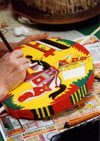 |
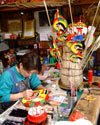 |
| |
|
Oshima
Tsumugi / Oshima Silk Pongee Fabric
Oshima tsumugi silk is known as one of the famous textiles in
Japan. It is the oldest dyed fabric with a tradition of more
than 1300 years. It is said that it was brought from China via
Okinawa, and it has been produced primarily on Amami Oshima
island. This silk is very light and doesn't crumple easily;
the deep blue-black color comes out by a special method of "mud
dying," and the beautiful patterns are hand-woven. Making
the Oshima pongee is a quite delicate and complicated process.
1) Making the thread for splashing spot: Cotton threads are
used for warp and silk threads for woof. Cotton threads prevent
dyestuff from penetrating the silk threads. 2) Dyeing: rub in
the solution of Sharinbai tree fifty to sisxty times, then knead
in the muddy rice field four or five times to oxidize the threads
in order to give them a beautiful black color. 3) Weaving: Skilled
workers weave the threads. They check the cross warps and woofs
carefully, every 7~8 cm and adjust these by using needles. It
takes more than 40 days to complete 1 tan (12m x 32cm in length)
As it is a very delicate process, Oshima pongee kimonos are
expensive. There are many products like kimono, tie, bags, tapestries
and clothes. |
Tane hasami
/ Scissors
The scissors were introduced by a Chinese blacksmith who was
on the ship, when the Portuguese introduced guns to Japan in
1543. The first landing place in Japan was Tanegashima island.
|
Chousa
・ Tarumizu Ningyo / Clay Doll
The doll is made in a mold, fired and colored. It is a simple
but unique doll. It follows a tradition of more than 400 years.
It is said that it was originally created by Korean potters.
There were about 40 producers of Chosa clay dolls before, but
only one person has taken over the tradition now.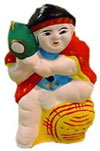 |
|
|
